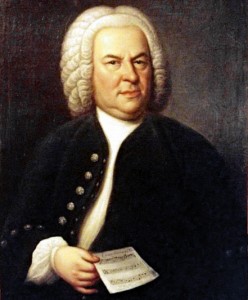Bach, Fugue in G Major, BWV 577 (“Gigue”)
 Since we all celebrated Bach’s birthday this week, I thought we should feature something festive by Bach. What, you missed his birthday? Pity, but it happens. A few years ago I went to Sunday services at the Thomaskirche in Leipzig (where Bach worked from 1727 until his death in 1750) only to recall once I got there that it was March 21st. I hadn’t expected the special music added for the occasion, and was pleasantly surprised.
Since we all celebrated Bach’s birthday this week, I thought we should feature something festive by Bach. What, you missed his birthday? Pity, but it happens. A few years ago I went to Sunday services at the Thomaskirche in Leipzig (where Bach worked from 1727 until his death in 1750) only to recall once I got there that it was March 21st. I hadn’t expected the special music added for the occasion, and was pleasantly surprised.
Bach has shown up in this series several times, as you might expect. But we have had only one Bach fugue, the Passacaglia and Fugue in C Minor, and that post focused more on the passacaglia than the fugue. Fugues were often paired with other forms in the Baroque era—a prelude and fugue, toccata and fugue, fantasia and fugue, etc. But fugues might also stand alone as this one does.
Fugues have a reputation for being dense and complicated. It’s true that they follow rather strict rules, and the contrapuntal texture can be challenging. But in some ways, fugues are rather easy to understand. They begin with a “subject”—usually a short statement of about 11 notes—stated in one voice. The second voice enters with the “answer,” which is the subject (or a slightly modified version of the subject) stated at a different pitch level. While the second voice states the answer, the first voice continues with new musical material. The third voice enters with a restatement of the subject, while the other two continue with counterpoint. If there is a fourth voice, as there is in this fugue, it enters with the answer. The sequence of all of the voices entering, stating alternately subject and answer, is called the “exposition.” If you understand the exposition, you know the most important part of the fugue. After the exposition, you will encounter the subject and answer multiple times in different guises.
Here’s where fugues are simple. The exposition, with its focus on clear statements of the thematic material, trains your ear in what to listen for throughout the work. As you get to know the fugue, you hear more ways in which the composer has used the subject to craft the entire piece.
The subject of the Bach fugue featured here is a bit unusual. For starters, it is long. And it has the rhythmic character of a gigue, a dance form popular as a final movement in Baroque suites. (Hence the nickname.) Focus on the exposition. It takes about one minute and the fourth voice enters in the pedal.



